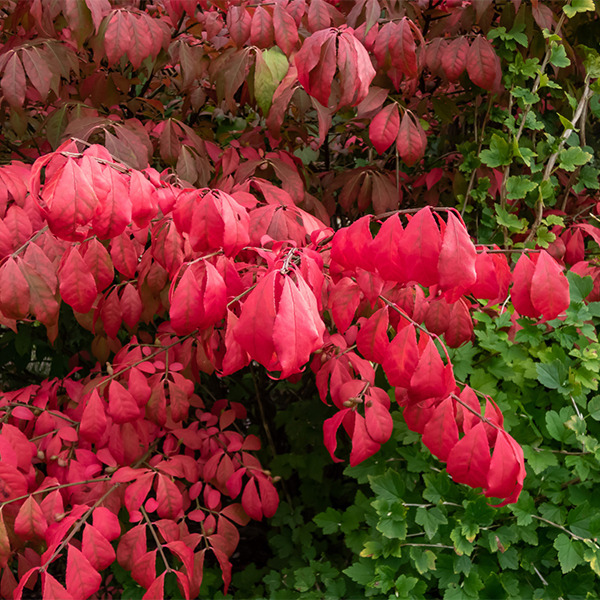One of the most strikingly-colorful plants during autumn in this region’s gardens is burning bush (Euonymus alatus). Unfortunately, burning bush (including its cultivars) is now classified as an invasive species, and anyone wanting to buy a plant will be frustrated. Although it’s still commonly seen in established gardens (and increasingly seeded-in to surrounding woodlands), purchasing any plants of the species is now illegal in Massachusetts.
Why is it that some plants are classified as invasive, while others that seem so similar are not? That’s a common question, particularly during autumn when fall colors and fruit on the burning bush (Euonymus alatus), oriental bittersweet (Celastris orbiculatus) and multiflora rose (Rosa multiflora) are so showy—they’re all considered “invasive” species.
Interestingly, poison ivy (Toxicodendron radicans), Virginia creeper (Parthenocissus quinquefolia) and blackgum (Nyssa sylvatica) all exhibit similar brilliant autumn features. But even though they can be noxious weeds and “thugs” when they dominate an area, they are native species, so they cannot be classified invasive.
According to the United States Department of Agriculture, “Only plants found in this country before European settlement are considered to be native to the United States.” A generally accepted principle is that plants classified as “native” cannot be considered invasive because they have “developed resistance to pests through their interaction with the pest over many generations”, whereas “invasive species are in a new environment, free from natural predators, parasites, or competitors, they often develop large population sizes very rapidly.”
Determining whether a species is invasive needs to be science-based, taking into consideration the characteristics of the species and the region where it grows. The Massachusetts Invasive Plant Advisory Group (MIPAG) defines invasive plants as “non-native species that have spread into native or minimally managed plant systems in Massachusetts, causing economic or environmental harm by developing self-sustaining populations and becoming dominant and/or disruptive to those systems.” MIPAG has developed and applies criteria to determine invasiveness of a species.
Fortunately for those of us who enjoy gardens, only a very small percentage of introduced, non-native plants (sometimes called “exotics”) are “invasive”. And for those of us who appreciate the attractiveness of burning bush, a good number of plants that exhibit similar features are reasonable substitutes. Some of these are native, others not:
- Red chokeberry (Aronia arbutifolia)
- Blueberry (Vaccinium corymbosum)
- Redvein enkianthus (Enkianthus campanulatus)
- Witch Alder (Fothergilla species & cultivars)
- Sweetspire (Itea cultivars)
- Sumac (Rhus species & cultivars)
As our climate continues to change, problems associated with invasive plants are increasing and becoming more complex, both for the health of the environment and for gardeners alike. Open this link for more information and specific suggestions for identifying and managing invasive plants.
Frequently Asked Questions about Invasive Species
https://www.invasive.org/101/moreinfo.com







